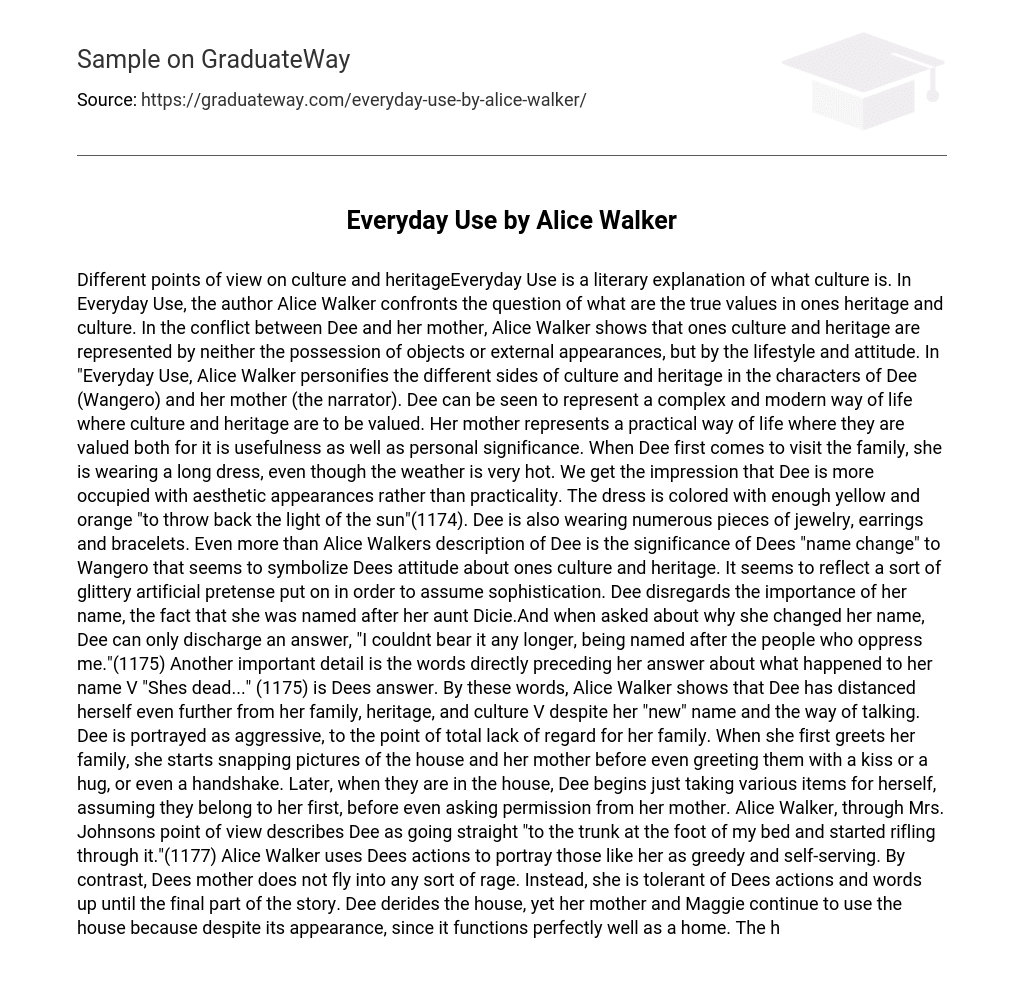Everyday Use is a literary explanation of what culture is. In Everyday Use, the author Alice Walker confronts the question of what are the true values in ones heritage and culture. In the conflict between Dee and her mother, Alice Walker shows that ones culture and heritage are represented by neither the possession of objects or external appearances, but by the lifestyle and attitude.
In “Everyday Use, Alice Walker personifies the different sides of culture and heritage in the characters of Dee (Wangero) and her mother (the narrator). Dee can be seen to represent a complex and modern way of life where culture and heritage are to be valued. Her mother represents a practical way of life where they are valued both for it is usefulness as well as personal significance. When Dee first comes to visit the family, she is wearing a long dress, even though the weather is very hot. We get the impression that Dee is more occupied with aesthetic appearances rather than practicality.
The dress is colored with enough yellow and orange “to throw back the light of the sun”(1174). Dee is also wearing numerous pieces of jewelry, earrings and bracelets. Even more than Alice Walkers description of Dee is the significance of Dees “name change” to Wangero that seems to symbolize Dees attitude about ones culture and heritage.
It seems to reflect a sort of glittery artificial pretense put on in order to assume sophistication. Dee disregards the importance of her name, the fact that she was named after her aunt Dicie.And when asked about why she changed her name, Dee can only discharge an answer, “I couldnt bear it any longer, being named after the people who oppress me.”(1175) Another important detail is the words directly preceding her answer about what happened to her name V “Shes dead…” (1175) is Dees answer.
By these words, Alice Walker shows that Dee has distanced herself even further from her family, heritage, and culture V despite her “new” name and the way of talking. Dee is portrayed as aggressive, to the point of total lack of regard for her family. When she first greets her family, she starts snapping pictures of the house and her mother before even greeting them with a kiss or a hug, or even a handshake. Later, when they are in the house, Dee begins just taking various items for herself, assuming they belong to her first, before even asking permission from her mother. Alice Walker, through Mrs. Johnsons point of view describes Dee as going straight “to the trunk at the foot of my bed and started rifling through it.”(1177)
Alice Walker uses Dees actions to portray those like her as greedy and self-serving. By contrast, Dees mother does not fly into any sort of rage. Instead, she is tolerant of Dees actions and words up until the final part of the story. Dee derides the house, yet her mother and Maggie continue to use the house because despite its appearance, since it functions perfectly well as a home.
The house can be seen as one of the aspects of the familys culture and heritage – being uneducated, poor descendents of slaves. Just as Dee hates the house she hates the uncomplicated life of poverty that her family lives in. Dee decline the house and yard, which symbolize of her familys past, at the same time she wants various objects in the house – a churn top, a dasher, and several quilts which are just as meaningful to the family history as the house and the yard are.
But they are reminders of the different views Dee and her Mother hold about culture and heritage. Dee views these items as works of art. Mother sees their practical value and actually makes use of them when Dee exclaims, “…they are priceless!(1177) it is because they are handmade by her family and she envisions some sort of monetary value. But what is really priceless is the actual ability to make these things.
Dee does not have this ability nor does she want it. She has declined her ability, part of her true heritage, while her mother and her sister still occupy it. Walker is trying to point out the motivations behind the characters – by Dees attitude toward the heirlooms of the family is a sign of either culture or heritage.
The story is clear to us that Dee is equally confused about the nature of her culture and heritage and Dees attitude is the irony and focal point of Alice Walkers entire story. Regardless of Dees worldliness and education, she neither knows nor values her real culture and heritage. Alice Walker shows that culture is neither name changes or bright dresses and different hair.
In the story, the culture gives us a unique perspective into people lives and the conflicts they face. The way of the conflict is handle in a decision left to the individual, who is guided by the cultural upbringing. Therefore, people who occupy their real heritage and culture makes use of it every day of their life.





